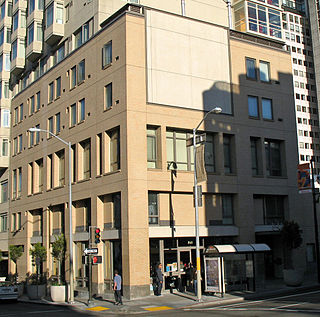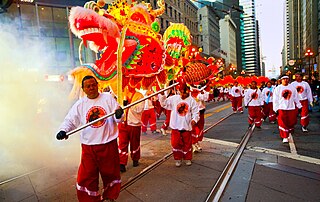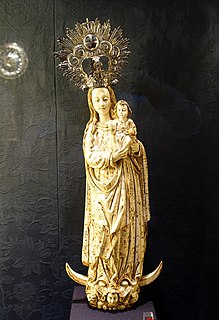
Ifugao is a landlocked province of the Philippines in the Cordillera Administrative Region in Luzon. Its capital is Lagawe and it borders Benguet to the west, Mountain Province to the north, Isabela to the east, and Nueva Vizcaya to the south.

Cordillera Administrative Region, also known as Cordillera Region, designated as CAR, is an administrative region in the Philippines, situated within the island of Luzon. The only landlocked region in the insular country, it is bordered by the Ilocos Region to west and southwest, and by the Cagayan Valley Region to the north, east, and southeast. It is the least populous region in the Philippines, with a population less than that of the City of Manila.

A Little Manila is a community with a large Filipino immigrant and descendant population. Little Manilas are enclaves of Overseas Filipinos consisting of people of Filipino origin living outside of the Philippines. This term applies to Filipinos who are both abroad indefinitely as citizens or permanent residents of a different country, and to those Filipino citizens abroad for a limited, definite period, such as on a work contract or as students. It can also include seamen and others who work outside the Philippines, but are neither permanent nor temporary residents of another country.

Talavera, officially the Municipality of Talavera, is a 1st class municipality in the province of Nueva Ecija, Philippines. According to the 2015 census, it has a population of 124,829 people.

The International Hotel, often referred to locally as the I-Hotel, was a low-income single-room-occupancy residential hotel in San Francisco, California's Manilatown. It was home to many Asian Americans, specifically a large Filipino American population. Around 1954, the I-Hotel also famously housed in its basement Enrico Banduccci's original "hungry i" nightclub. During the late 60s, real estate corporations proposed plans to demolish the hotel, which would necessitate displacing all of the I-Hotel's elderly tenants. In response, housing activists, students, community members, and tenants united to protest and resist eviction. All the tenants were evicted on August 4, 1977 and the hotel was demolished in 1981. After the site was purchased by the International Hotel Senior Housing Inc., it was rebuilt and opened in 2005. It now shares spaces with St. Mary's School and Manilatown Center.

Tourism is an important sector for Philippine economy. In 2015, the travel and tourism industry contributed 10.6% to the country's GDP. Philippines is an archipelagic country composed of 7,641 islands with 82 provinces divided in 17 regions. The country is known for having its rich biodiversity as its main tourist attraction. Its beaches, heritage towns and monuments, mountains, rainforests, islands and diving spots are among the country's most popular tourist destinations. The country's rich historical and cultural heritage, including its festivals and indigenous traditions, are also one of the attractions of Philippines. Popular destinations among tourists are Cebu, Boracay, Palawan, Siargao, and many more.

The Rice Terraces of the Philippine Cordilleras were inscribed on the UNESCO World Heritage List in 1995, the first-ever property to be included in the cultural landscape category of the World Heritage List. This inscription has five sites: the Batad Rice Terraces, Bangaan Rice Terraces, Mayoyao Rice Terraces, Hungduan Rice Terraces and Nagacadan Rice Terraces, all in Ifugao Province, Philippines. The Ifugao Rice Terraces reach a higher altitude and were built on steeper slopes than many other terraces. The Ifugao complex of stone or mud walls and the careful carving of the natural contours of hills and mountains to make terraced pond fields, coupled with the development of intricate irrigation systems, harvesting water from the forests of the mountain tops, and an elaborate farming system.

Nela Álvarez was a Filipina pre-war actress who usually played a mother role in LVN Pictures.

Kearny Street in San Francisco, California runs north from Market Street to The Embarcadero. Toward its south end, it separates the Financial District from the Union Square and Chinatown districts. Further north, it passes over Telegraph Hill, interrupted by a gap near Coit Tower.

Maria Jessica Aspiras Soho is a Filipino broadcast journalist known as the host of the news magazine program Kapuso Mo, Jessica Soho on GMA Network and the newscast State of the Nation with Jessica Soho on GMA News TV.

The San Francisco Chinese New Year Festival and Parade is an annual event in San Francisco. Held for approximately two weeks following the first day of the Chinese New Year, it combines elements of the Chinese Lantern Festival with a typical American parade. First held in 1851, along what are today Grant Avenue and Kearny Street, it is the oldest and largest event of its kind outside of Asia, and the largest Asian cultural event in North America. The parade route begins on Market Street and terminates in Chinatown.

Kearny Street Workshop (KSW) in San Francisco, California, is the oldest multidisciplinary arts nonprofit addressing Asian Pacific American issues. The organization's mission is to produce and present art that enriches and empowers Asian Pacific American communities. Notable participants include author and Asian American studies scholar Russell Leong, playwright and author Jessica Hagedorn, author Janice Mirikitani, poet and historian Al Robles, and actor and filmmaker Lane Nishikawa.

Kesong puti is a Filipino soft, unaged, white cheese made from unskimmed carabao milk and salt curdled with vinegar, citrus juices, or sometimes rennet. It can also be made with goat or cow milk. It has a mild salty and tart flavor. When an acidifying agent is used, it resembles queso blanco or paneer. When rennet is used, it resembles buffalo mozzarella. Moisture content can also vary, ranging from almost gelatinous to pressed and firm. It can be eaten as is, paired with bread, or used in various dishes in Filipino cuisine. It is usually sold wrapped in banana leaves.

Arts in the Philippines refer to the various forms of the arts that have developed and accumulated in the Philippines from the beginning of civilization in the country up to the present era. They reflect the range of artistic influences on the country's culture, including indigenous forms of the arts, and how these influences have honed the country's arts. These arts are divided into two distinct branches, namely, traditional arts and non-traditional arts. Each branch is further divided into various categories with subcategories.
Ronald James Gibbs, popularly known by his on-screen name Ronaldo Valdez, is a veteran Filipino film and television actor whose career spanned for almost five decades.
Intangible cultural heritage (ICH) includes traditions and living expressions that are passed down from generation to generation within a particular community.
Kularts is a San Francisco, California,-based non-profit organization founded in 1985. It presents contemporary and tribal Filipino arts. Its mission is to expand the understanding of American Filipino culture, through sponsoring productions and presentations in the United States. Through its programs of performances, visual arts, community dialogues, and festivals, the organization hopes to advance the spirit and integrity of ancestral Filipino art and cultures.
Manilatown was a Filipino American neighborhood in San Francisco, which thrived from the 1920s to late 1970s. The district encompassed a three block radius around Kearny and Jackson Streets, next to Chinatown. The neighborhood was known for the International Hotel, a single room occupancy (SRO) hotel where many of the residents lived. Manilatown was also home to many businesses that catered to the Filipino American community, such as Manila Cafe, New Luneta Cafe, Bataan Lunch, Casa Playa, Sampagita Restaurant, Blanco's Bar, Lucky M. Pool Hall, and Tino's Barber Shop. At its height, over 1000 residents lived in Manilatown, and it contained a total of 30,000 transient laborers. From the late 1960s-70s, the neighborhood was transformed by city initiatives that aimed to gentrify the area. By 1977, the neighborhood had been largely destroyed, and it became part of Chinatown.
















